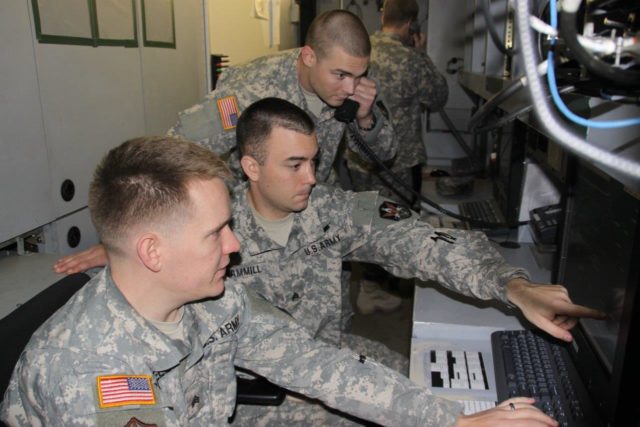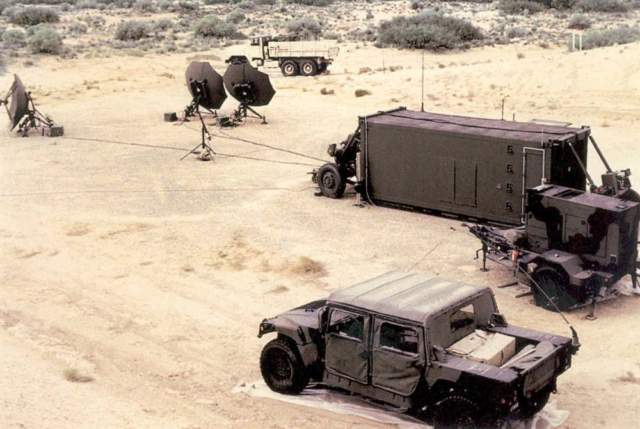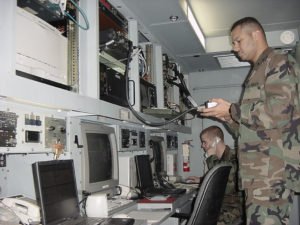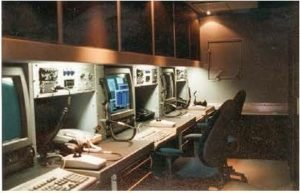
By Sharon Watkins Lang
Command Historian U.S. Army Space and Missile Defense Command Army Forces Strategic Command
The Army fielded the first production model Joint Tactical Ground Station (JTAGS) at Kelley Barracks, Feb. 19, 1997.
With little fanfare, the 15 member JTAGS- Europe Detachment, also known as the 15th Air Defense JTAGS Det., became the first unit equipped and working 24/7/365 operations.
Although not widely reported, the event was significant. JTAGS brought a much-needed early warning capability to the warfighter. Within three months, five JTAGS units were received, tested and fielded, and the production line closed, part of a Pentagon initiative to expedite prototype production and acquisition. However, the name and the unobtrusive shelter do little to relay the significance of the JTAGS system and mission.
“I hope I never hear from you,” said Air Force Lt. Gen. Joseph Hurd, commander, Osan Air Base, Korea. Hurd was addressing the second deployed JTAGS unit at its dedication ceremony in 1997.
Before JTAGS
The origins of the JTAGS mission can be traced to Huntsville, Ala., ten years earlier. In the late 1980s, the then U.S. Army Strategic Defense Command (USASDC) was tasked to develop a Theater Missile Defense Architecture Study and conduct an assessment of potential near term solutions to counter the growing tactical ballistic missile threat. (The USASDC was a predecessor to the U.S. Army Space and Missile Defense Command/Army Forces Strategic Command. It is headquartered at Redstone Arsenal, Ala.)

Part of these initiatives was a study using space-based sensors to create a satellite early warning system: could satellites originally launched to detect strategic missile and space launches and nuclear explosions see and track smaller tactical missile launches? Within a year, USASDC and prime contractor Aerojet Electronic Systems Division were ready to conduct demonstration tests at White Sands Missile Range using pre-recorded data from the Defense Support Program (DSP), an Air Force program that operates reconnaissance satellites. Held in the summer of 1989, this series of tests “provided a ‘proof of principle’ demonstration of the value of in-theater early warning.” The algorithms and processing software also provided a foundation for the next phase in development.
The follow-on program, the Tactical Surveillance Demonstration (TSD), began in August 1990 and just eight days later the Iraqi army invaded Kuwait. Rather than accelerate TSD development, the U.S. Space Command developed the Tactical Event Reporting System (TERS) using existing hardware and networks. The DSP satellites would provide warning of a tactical ballistic missile attack to their Missile Warning Center at Cheyenne Mountain, Colorado, which was tied to U.S. Central Command’s theater air and missile defense network. Once the Center received the launch warning, it would transmit the warning and subsequent updates to the theater over voice line. Within the theater, the alerts were then relayed via telephone and radio networks, as needed. Despite its “inherent limitations”, the TERS provided broad early warning alerts and cuing data to enable various Theater Missile Defense (TMD) systems to intercept the threat. While the concept worked, the events of Operation Desert Storm identified critical deficiencies in the theater early warning system.

In the interim, research continued on the TSD with Aerojet pursuing hardware and software improvements and maximizing commercial off-the-shelf technology to manage costs and the timeline. The project also became increasing joint in nature as the Naval Space Command provided funding as well as technical and programmatic support. In addition, TSD software was provided to the Air Force to support their Talon Shield early warning project. Prototype testing ran from February through August 1992 and demonstrated enhanced communications connectivity to include cuing data transferred via Tactical Information Broadcast System radios to a Patriot fire control system. The TSD proved that a small, in-theater processing center could effectively assess data provided directly from the DSP satellites. Also during this period, an agreement between the Army and the Navy established that the TSD systems would be manned by crews from both the Army Space Command and the Navy Space Command.
The next phase – TSD-Enhanced saw the TSD transferred to Europe in January 1993. Operational within two weeks, the TSD successfully participated in a number of exercises employing both taped and live data. These and earlier tests helped identify the specific systems and capabilities needed to create a viable JTAGS operation. And, within months, the PEO had activated the process to make the JTAGS a formal acquisition program. They later reported that “based on the immense success shown by the TSD demonstration, Department of the Army directed [them] to ‘aggressively pursue acquisition and near term fielding’ of a deployable JTAGS capability.” Four years later the Product Office achieved this goal with the first unit equipped in Stuttgart; just ten years from concept to delivery.

Thus, while the JTAGS can be described as “a mobile information processing system” it is much more than that. With data from space-based assets, the JTAGS is a key factor in “establishing and maintaining information dominance.” The JTAGS supports all three pillars of what was then called Theater Missile Defense (active defense, passive defense and attack operations). JTAGS provides the specific track and cuing information needed to employ an effective active defense – destroy the threat with TMD interceptors. JTAGS data processing provides more specific impact point predictions to warn ground forces and the local populace of a missile attack – passive defense.
Finally, data from the JTAGS can support attack operations by identifying initial launch points. The theater deployed JTAGS, adapted to use local communications systems, provides the shortest link between the sensor and the shooter and therefore the earliest warning times.
